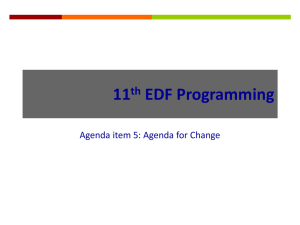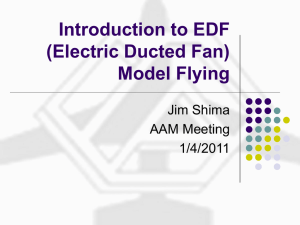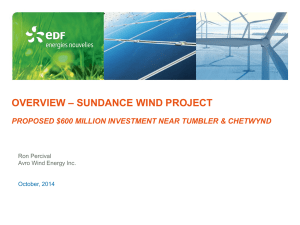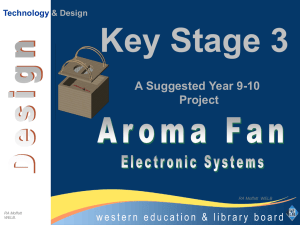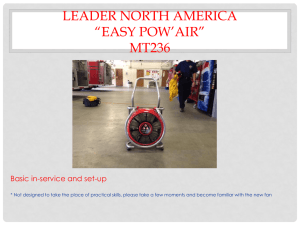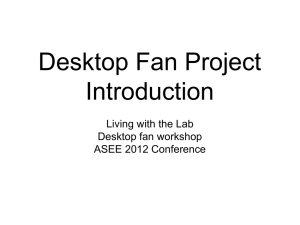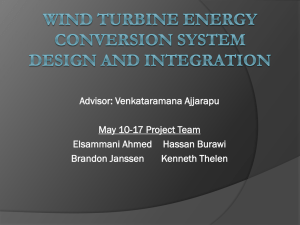EDF (Electric Ducted Fan) RC Planes
advertisement
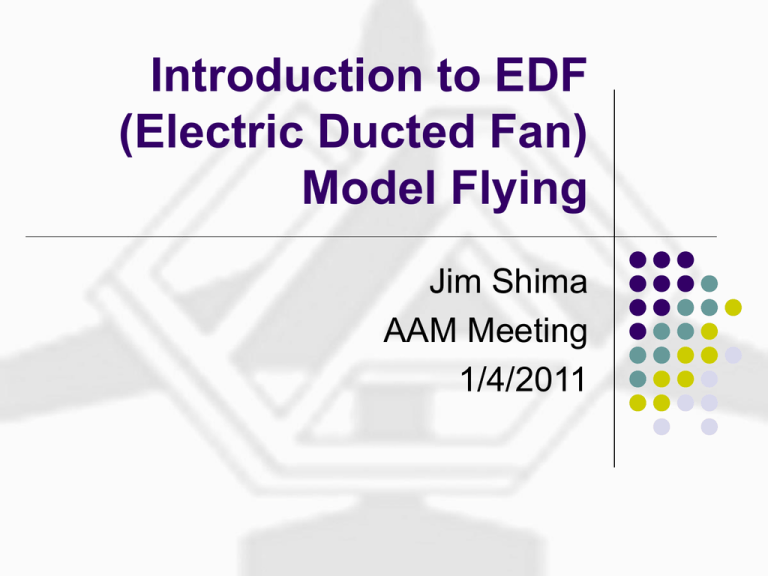
Introduction to EDF (Electric Ducted Fan) Model Flying Jim Shima AAM Meeting 1/4/2011 Apropos to RC Model Flying “Aviation in itself is not inherently dangerous. But to an even greater degree than the sea, it is terribly unforgiving of any carelessness, incapacity, or neglect.” — Captain A. G. Lamplugh, British Aviation Ins Group, c. early 1930's. “There are two critical points in every aerial flight - its beginning and its end.” — Alexander Graham Bell, 1906. EDF Overview With the advance of battery technology and brushless motors, EDF offerings have exploded and gained popularity in the past 3-4 yrs. Foam molding has allowed almost any plane/military jet in EDF form to come to market. Larger 15+ lb. fiberglass/composite EDFs have also gained traction in the hobby – even rivaling turbine performance (BVM/Tamjets). Li-Po battery technology allows for larger planes and more powerful fan units (sourcing several hp). EDF units vary from 50mm small fans to over 120mm. Some sizes are “standard”, but there are also manufacture specific sizes. EDF Basics Brushless motors used due to their high efficiency. Motors are rated with “KV” spec. This denotes the motors unloaded RPM per volt. Ex: 4000KV is 4000 RPM/volt. With 10V going to the motor, the RPM would be 40,000. EDFs max out around 50-65k RPM. Must scale the motor and battery to match the EDF unit. More blades -> lower KV motor, less blades->higher KV motor. Static thrust is governed by fan diameter, motor RPM, number of fan blades. Stators on the back of the EDF housing straighten out airflow. Inlet lip/flange has great effect on static thrust – keep ducting and inlet smooth! Typical EDF Setup Fan unit (rotor, housing, collar, rotor plug) Brushless motor (size/KV depends on fan diameter) Brushless ESC - max amperage depends on fan size+motor (30100A) Battery pack size (2s-12s lipo) and capacity (1300-10,000mAh) depending on above Optional BEC (most ESCs have built in BEC circuit, 2-3A) Thrust tube Any 5 to 9 channel RC radio and Rx (2.4G preferred but not necessary) EDFs at Altitude What Combo is Right? Some stock RTF planes will be sluggish at our altitude. Typically a motor/ESC upgrade will solve the problem. Nowadays some larger 90mm and up RTFs will do ok stock – upgrades are an option to get better performance. Thinner air can increase RPM/current draw compared to sea-level data. EDF combos I’ve used at altitude with great success: XF 55mm 3-blade fan w/ Don’s wicked extreme 5400kV on 4s - easy 100+ mph (Phase 3 F-16) 64mm “EDO” type or SF/Eflite w/ Don’s wicked 4000-4800kV motors on 4s lipo (Eflite F-15, FW SU-34) 70mm HET 6904 w/ Typhoon 2W-20 on 4s (Xflight A-7, HL F-5). 90mm HL stock setup on 6s (F-18, EF2000). 69mm Eflite Delta V on 4s: 5s possible with new ESC (Habu) . www.donsrc.com has lots of eagle tree power/current data on motor-fan combos in different sizes. Use as a good starting point. Experimenting yourself will also give you invaluable data (simple thrust stand can be built). Advanced EDF Info EDF does not compress air like a turbine, just forces it through the fan. Fan housing mitigates blade tip losses and allows higher operating RPM. Not as much unloading in the air like a normal prop. Clearance between blade tips and housing is important. Less clearance = more thrust. Centering the fan rotor is also crucial. At high RPM the blades will actually stretch out. Efflux/exhaust velocity governed by the thrust tube’s area versus the FSA (fan swept area). Smaller thrust tube diameter sacrifices thrust for higher max speed. Typical thrust tube/tailcone is about 80% FSA (more speed) to 90% FSA (more thrust). Anything impeding exhaust airflow will result in turbulent flow and greatly reduce thrust. Some EDF airframes do not have sufficient inlet ducting to “feed” the fan. In this case the plane has “cheater” holes – these allow enough air flow into the fan so it is not starved. The holes increase static thrust but should not be made too large. Flying an EDF/Turbine Model Anyone can fly one if you abide by simple rules On takeoff/launch let the model get “on step” before giving it large control surface input. Thrust is not immediate, think 2 sec ahead. Make wider turns, remember you don’t have a prop pushing air over the wings. Military jet models have higher-wing loadings and stall easier – don’t expect to glide it in. Land with some power! Allows you to get out of situations. I like at least ¼ throttle to touchdown. Set your timer conservative. First flight should be short so you have little chance of going into battery LVC. In short, fly it like a jet and things will go well. What Else? Many models today have built-in thrust vectoring for aerobatics (high alpha, Cobra, flat spins, Harrier) If you are a speed junkie, EDFs can easily satisfy your speed appetite (foam up to 160 mph, glass up to 200+ mph) Scale flight is overlooked. Look ma, no prop! EDFs allow you to fly in short order w/o going through time-consuming fueling, assembly, and starting procedures (convenience factor). If you are looking to advance into turbines, EDFs offer an economical way to “fly-before-big-buy” (EDF=$100’s, turbines=$1000’s) Most EDF planes (even small ones) have flight characteristics like their larger turbine counterparts. Beginner Foam EDF Models Phase 3 F-16 – www.hobbypeople.net Phase 3 U2 – www.hobbypeople.net ParkZone Habu – www.horizonhobby.com Hobby Lobby - Executive jet (SFM), EF2000 eurofighter (FreeWing), F-35. Others include C-17, F-86, Twister, etc Accessories for Getting Started ESC programming card (set up LVC, motor timing) Wattmeter (check motor current draw) LiPo batteries – 30 to 40c if available LiPo balance battery checker (field check batts) LiPo battery balance charger Real-time battery monitor (Quanum, Hitec, Weatronics). Helps you monitor battery voltage and avoid surprise LVC. Eagle Tree logger (for more advanced testing) Some Web Sites Don’s RC: www.donsrc.com Everything EDF up to 70mm Wicked motors are some of the best. Hobbywing ESCs and dynamically-balanced fans. Hobby Lobby: www.hobby-lobby.com Mostly ARF/RTF planes. HobbyCity/HobbyKing: www.hobbycity.com Tons of fans and motors to choose from. Turnigy ESCs, Lipo batteries, chargers, etc. Also has wattmeters, Quanum telemetry unit. Economical way to get into EDFs. Turbo Fan Electrics: www.turbofanelectrics.com Lots of planes, HET fans and motors. Philip’s workshop: www.pw-rc.com Great customer service and offers newest jets at a discount, Hobbywing ESCs. Electric Jet Factory: www.ejf.com Good selection of differentsize and type of EDFs, motors, planes. Tamjets: www.tamjets.com Example for getting into larger (and more expensive) EDF planes 100mm+. Have Fun! (Q&A after Sid)
